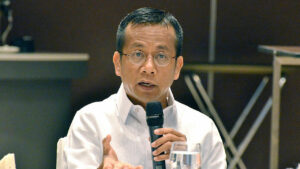NATIONAL ECONOMIC and Development Authority (NEDA) Secretary Arsenio M. Balisacan said the government is preparing to be less reliant on official development assistance (ODA) once the Philippines achieves upper middle-income status.
“The price of becoming an upper middle-income country is we lose this access to concessional loans, subsidized loans and grants from the usual development partners like the World Bank and the Asian Development Bank (ADB). That’s why even at this point, we are preparing for that eventuality,” he said during a briefing on Wednesday.
The World Bank classifies the Philippines as a lower middle-income economy, with gross national income (GNI) per capita of $3,950 in 2022.
The World Bank norm for lower middle-income countries is a GNI per capita of $1,136-$4,465. The bracket for upper middle-income economies is set at $4,466-$13,845.
“Between the choice of remaining a lower middle-income country and keeping access to concessional loans, we’d rather go for (becoming) an upper middle-income country. That would mean a higher standard of living for Filipinos, high-quality jobs, and a reduction of poverty,” he added.
In 2021, the Philippines’ active ODA loan and grant portfolio was valued at $32.24 billion. This consisted of 107 loans and 297 grants.
This year, the National Government is expected to obtain around $19.1 billion worth of ODA, of which $9.2 billion in loans will be sourced from multilateral development partners and $9.8 billion from bilateral lenders.
Mr. Balisacan said that the rise to upper middle-income status is “On track. Upper middle-income status will be achieved in 2025 based on our estimates and given current assumptions. (We are) hoping for no major disasters or external factors,” he said.
“We should have been an upper middle-income country by now if not for the sharp contraction of the economy in 2020. We lost three years as a result of that contraction,” he added.
To prepare for the reduced access to ODA, Mr. Balisacan said that the government is working on making the public-private partnership (PPP) system “more robust.”
“(We need to make) the governance of PPPs more robust so that we can have those key projects like infrastructure funded by PPPs,” he said.
“The Maharlika Investment Fund is also aimed at that. We can use that facility to attract other forms of capital to fund those critical infrastructure and social projects,” he added.
The Philippines has been classified as a lower middle-income economy since 1987.
Mr. Balisacan said that the government is expected to meet its 6-7% target for the year.
“For us to reach the lower end of the range, we must grow something like 5.9% for the three quarters,” he said.
The economy grew 6.4% in the first three months, slower than the revised 7.1% in the previous quarter, and the 8% posted in the first quarter of 2022.
It was also its lowest growth in two years or since the 3.8% contraction in the first quarter of 2021.
“If we hit the lower end, that’s still a remarkable performance. Everywhere else, it’s a downgrade; the external environment is much improved,” he added.
Mr. Balisacan also noted that the impact of the ongoing El Niño on the economy will not be substantial.
“The impact is not very significant in terms of GDP. Our assessment of the impact of the El Niño given the data we have received from PAGASA is that it is not going to be substantial,” he added.
Earlier this month, the government weather service, known as PAGASA (Philippine Atmospheric, Geophysical and Astronomical Services Administration) declared the onset of the El Niño weather pattern. It is expected to persist until the first quarter of 2024.
The World Meteorological Organization also announced the emergence of the El Niño for the first time in seven years in the Tropical Pacific.
Despite minimal impact on growth, Mr. Balisacan called for the need to support agriculture.
“Agriculture is where a lot of the poor are; we have to be extra active there. We have to be proactive in providing assistance measures to ensure that they are taken care of, especially in relation to access to inputs, even for maintenance, like some form of subsidies,” he said.
The Philippines’ last El Niño weather event was in 2019, with agricultural damage estimated at up to P8 billion.
The Philippines’ worst El Niño episode was in 1998, when the economy contracted by 0.5% after agricultural production fell by 7%. — Luisa Maria Jacinta C. Jocson

